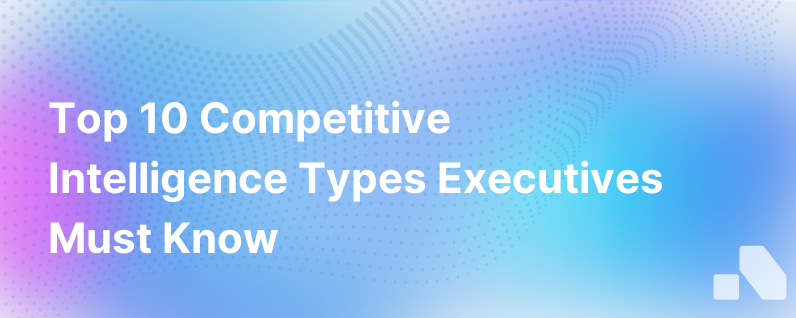Top 10 Types Competitive Intelligence
Published on December 6, 2023 by David Zhang
In the fiercely competitive B2B market, having actionable competitive intelligence (CI) can be the difference between leading the pack and lagging behind. CI offers countless tactical and strategic advantages, guiding businesses through an ever-changing landscape by revealing competitor movements, market trends, and customer needs.
Below, we explore the top 10 types of CI that are indispensable tools within the B2B sales arena.
1. Product and Service Intelligence
Knowing the details of your competitors' offerings is essential. Product feature comparisons, service level agreements, and unique selling propositions can fine-tune your go-to-market strategies and provide crucial talking points for sales representatives.
2. Pricing Analysis
Understanding the pricing models and strategies of competitors allows you to position your offerings compellingly. From subscription models to one-off pricing and discount structures, a complete analysis can inform your own pricing decisions to remain competitive.
3. Sales and Marketing Strategies
Analyzing how rivals approach the market — from their messaging and value proposition to their sales tactics, channel strategies, and lead-gen efforts — provides insights to inform your sales playbooks and marketing campaigns.
4. Market Share and Positioning
Monitoring market share fluctuations and positioning changes offers a macro view of competitive dynamics. It helps predict trends, potential market saturation, and aids in identifying opportunity gaps.
5. Customer Perceptions and Satisfaction
Customer reviews, testimonials, and case studies give an outside-in view of a competitor's strengths and weaknesses. This can guide your strategies to capitalize on gaps in customer satisfaction and brand perception.
6. Strategic Partnerships and Alliances
The partnerships competitors form can influence market dynamics. Understanding the nature of these partnerships provides insights into their strategic direction and potential market advantages.
7. Technological Developments
Keeping track of technological advancements and innovations leveraged by competitors can ensure you are not left behind. It presents opportunities for differentiation or potential areas for technology partnerships.
8. Regulatory Changes
In industries with tight regulatory controls, tracking how competitors deal with regulations can offer lessons for your compliance strategies and avoid potential pitfalls.
9. Competitive Benchmarking
Benchmarking involves comparing your organization’s processes and performance metrics to industry bests and best practices from other companies. By doing so, you can understand how you stack up and identify areas for improvement.
10. Financial and Operational Health
Financial reports, funding news, and operational insights provide a wealth of information for understanding a competitor's stability and capacity for investment, innovation, and strategic moves.
Now, here's the essential consideration: How do you actually gather and analyze these types of competitive intelligence effectively?
Gathering and Harnessing Competitive Intelligence Effectively
Utilizing public filings, news alerts, social media monitoring, and customer feedback are start points. However, the real competitive edge lies in leveraging advanced data-gathering tools and platforms that use AI to synthesize large volumes of data, capable of distilling actionable insights at the right time.
Here's a simplified pathway:
- Implement systematized tracking: Using competitive intelligence software that provides real-time data on competitor activities.
- Encourage cross-team collaboration: Sales need to work closely with marketing, product development, and market research teams to ensure a comprehensive intelligence gathering.
- Iterate and adapt your sales strategies: Insights should be used for training sales reps and adjusting sales strategies in response to the competitive landscape.
If this seems like a daunting task, you are not alone. Many B2B organizations, particularly startups and SMEs, find themselves strapped for time and resources to dedicate to such comprehensive intelligence gathering.
Embracing Technology to Streamline Competitive Intelligence
Platforms like Aomni are stepping into this gap by providing AI-powered tools that do the heavy lifting for you. Imagine being able to access real-time account research, competitive insights, and personalized sales content with zero effort — this is where technology is taking the sphere of competitive intelligence.
Aomni, for instance, caters to the real needs of B2B sales by delivering the necessary tools to sell more strategically without inundating teams with data to sift through. Instead of your sales team spending hours on endless research, Aomni provides concise, actionable insights within minutes, allowing you to focus on what you do best — selling.
In essence, the strategic application of competitive intelligence can illuminate the path to sales success, and by leveraging the right tools, your sales team can navigate the B2B landscape with unprecedented agility and insight. Whether you're crafting your initial strategy or adapting to market movements, staying informed with competitive intelligence is an indispensable aspect of sales success.
Sources:
- 5 Types of Competitive Intelligence to Impress Your Boss
- Top Business Intelligence Trends of 2024: A Comprehensive Guide
- A Practitioner's Complete Guide to Competitive Intelligence
- Best Competitive and Market Intelligence Tools for Technology and Service Providers Reviews 2024 | Gartner Peer Insights
- Top 10 Competitive Intelligence Tools To Beat The Competition
- What are some common methods of gathering competitive intelligence (CI)?
- The 14 Best Competitive Intelligence Tools for Market Research
- 10 Essential Examples of Competitive Intelligence | Crayon